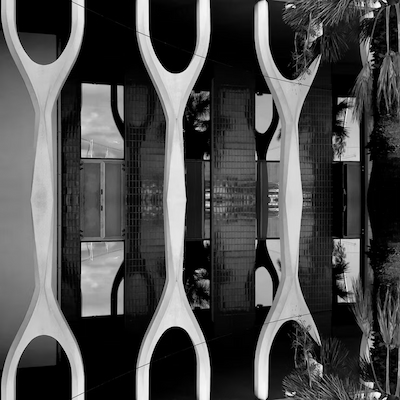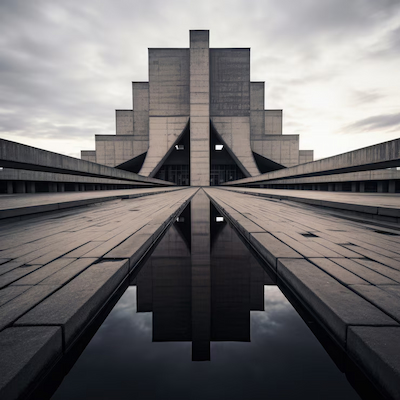
Brutalism is an architectural style that emerged in the 20th century, characterized by the use of exposed concrete, geometric forms, and an aesthetic that moves away from ornamentation. In Brazil, this movement gained strength mainly during the 1950s and 1960s, reflecting a context of modernization and innovation. While influenced by international trends, Brutalism in Brazilian architecture developed its own identity, adapting to the country’s unique cultural and social realities.
Brutalist architecture in Brazil is not just about aesthetics; it carries strong symbolism and seeks to create a new architectural language that responds to social and urban needs. Landmark buildings like the Conjunto Nacional in São Paulo and the University of Brasília illustrate how Brutalism became interwoven with Brazilian identity and history, creating monuments that represent an era of transformation.
How the Principles of Brutalism Work in Brazilian Architecture
The principles of Brutalism in Brazilian architecture are based on functionality, material honesty, and structural expression. Exposed concrete is a hallmark, providing not only a robust aesthetic but also showcasing the raw essence of the material. This aesthetic choice reflects a philosophy that values authenticity and transparency, allowing buildings to tell their own stories.
Brutalism in Brazil is also deeply connected to urban space. Brutalist buildings are designed to interact with their surroundings, contributing to a cohesive urban context. Spatial organization and volumetry aim to enhance circulation and integration, creating environments that promote engagement and connectivity.
Another key aspect is the pursuit of a language that reflects local culture. Brazilian Brutalism does not merely replicate foreign models; it incorporates local textures, colors, and cultural references. This fusion creates uniquely Brazilian works that express the country’s diverse identity.
Sustainability is becoming an increasingly important principle in contemporary Brutalism. Using local materials and implementing environmentally conscious solutions highlight Brutalism’s evolving role in addressing present-day needs and responsibilities.

Advantages of Adopting Brutalism in Brazilian Architecture
Adopting Brutalism in Brazilian architecture offers several advantages beyond its striking visual impact. One major benefit is structural durability. Concrete is known for its strength and longevity, making Brutalist buildings low-maintenance—a practical choice for Brazil’s diverse climate conditions.
Brutalism also allows great design flexibility. It offers a wide range of forms and configurations, enabling architects to explore bold, innovative solutions tailored to specific project needs.
Brutalist architecture can foster social interaction. These buildings often include communal spaces like plazas and gardens, encouraging public use and collective experiences—essential in urban contexts to enhance quality of life.
Brutalism contributes to cultural and historical value. Iconic buildings can become local landmarks, attracting visitors and celebrating regional identity. This cultural enrichment also has economic benefits, stimulating tourism and local development.
How to Incorporate Brutalism in Brazilian Architecture Projects
Successfully incorporating Brutalism in Brazilian projects requires a deep understanding of its principles and a careful analysis of the site context. Here are key guidelines:
Study the Context: Conduct a thorough analysis of the project’s location, including urban, social, and environmental aspects, to ensure the building harmonizes with its surroundings.
Use Local Materials: Embrace materials that reflect regional culture. While concrete is central, incorporating local stone or wood can enhance authenticity and contextual relevance.
Emphasize Form: Bold volumetric forms and impactful geometries are central to Brutalism. Explore unconventional facades, angles, and textures to create compelling architectural statements.
Include Public Spaces: Integrating communal areas such as gardens and plazas into the design supports social interaction and shared use.
Prioritize Sustainability: Address environmental concerns through green solutions like solar panels or rainwater harvesting, aligning Brutalism with modern ecological demands.
Encourage Experimentation: Brutalism invites creative exploration. Designers should feel free to innovate with materials and structural expressions to create bold, functional, and thought-provoking architecture.
Incorporating Brutalism in Brazilian architecture is not just about aesthetics—it’s an opportunity to create meaningful spaces that reflect culture, history, and community needs.
Brutalism in Brazilian architecture is a fascinating topic that reveals much about the country’s cultural identity. With its bold forms and expressive use of concrete, this style transforms urban landscapes and provokes thought about the relationship between architecture and society.
More than a mere aesthetic, Brazilian brutalism represents a powerful intersection of art, engineering, and social values. It challenges traditional notions of beauty, emphasizing raw materiality and structural honesty while celebrating the cultural diversity and complexity of Brazil. These buildings don’t just stand—they speak. They tell stories of resilience, ambition, and transformation.
If you’re intrigued by this architectural approach, there is much more to discover. From iconic institutions in Brasília and São Paulo to lesser-known regional projects, brutalism offers a lens through which to explore the evolution of Brazilian urban life. Today, as sustainability, equity, and community space become central themes in architecture, the legacy of brutalism continues to gain relevance—offering lessons in permanence, purpose, and cultural resonance.
Exploring brutalism invites a deeper understanding of the complexity and beauty of Brazilian architecture. It is an invitation to see cities not just as collections of buildings, but as living environments shaped by vision, material, and meaning. Let its concrete forms guide you through Brazil’s architectural history—and into its bold, ongoing future.
Frequently Asked Questions
What is Brutalism in Brazilian architecture?
Brutalism in Brazilian architecture is a style known for its use of concrete, emphasizing texture and simple forms. It aims to showcase structure in a raw, honest way.
What are the main characteristics of Brutalism?
Key features include exposed concrete, geometric shapes, and large-scale structures. It conveys a sense of strength and solidity.
Why is Brutalism important to Brazilian identity?
Brutalism reflects Brazilian identity by blending tradition with modernity. It captures local culture while embracing innovative architectural language.
Where can we find examples of Brutalism in Brazil?
You can find examples in cities like São Paulo and Brasília. Notable buildings include the Museum of Contemporary Art and the Ministry of Education building.
Does Brutalism influence current architecture?
Yes, Brutalism continues to influence architects today. The interest in raw materials and textured surfaces remains strong in contemporary design.


